Healthcare Governance and Performance Management: Case Study Report
VerifiedAdded on 2023/06/05
|10
|1770
|226
Report
AI Summary
This report examines the organizational governance and performance management within the healthcare sector, using the Bundaberg Hospital case as a primary example. It details the clinical governance failures, including inadequate performance monitoring, ineffective audit systems, and a concealment culture. The report explores the reasons behind the prolonged tenure of a surgeon involved in malpractice and outlines governance mechanisms that could have prevented the failings, such as abandoning an economic-focused culture, providing financial incentives for experienced doctors, and ensuring appropriate peer engagement. The conclusion emphasizes the importance of learning from past mistakes to enhance service quality and safeguard the healthcare system's reputation. The report references various academic sources to support its findings and recommendations.
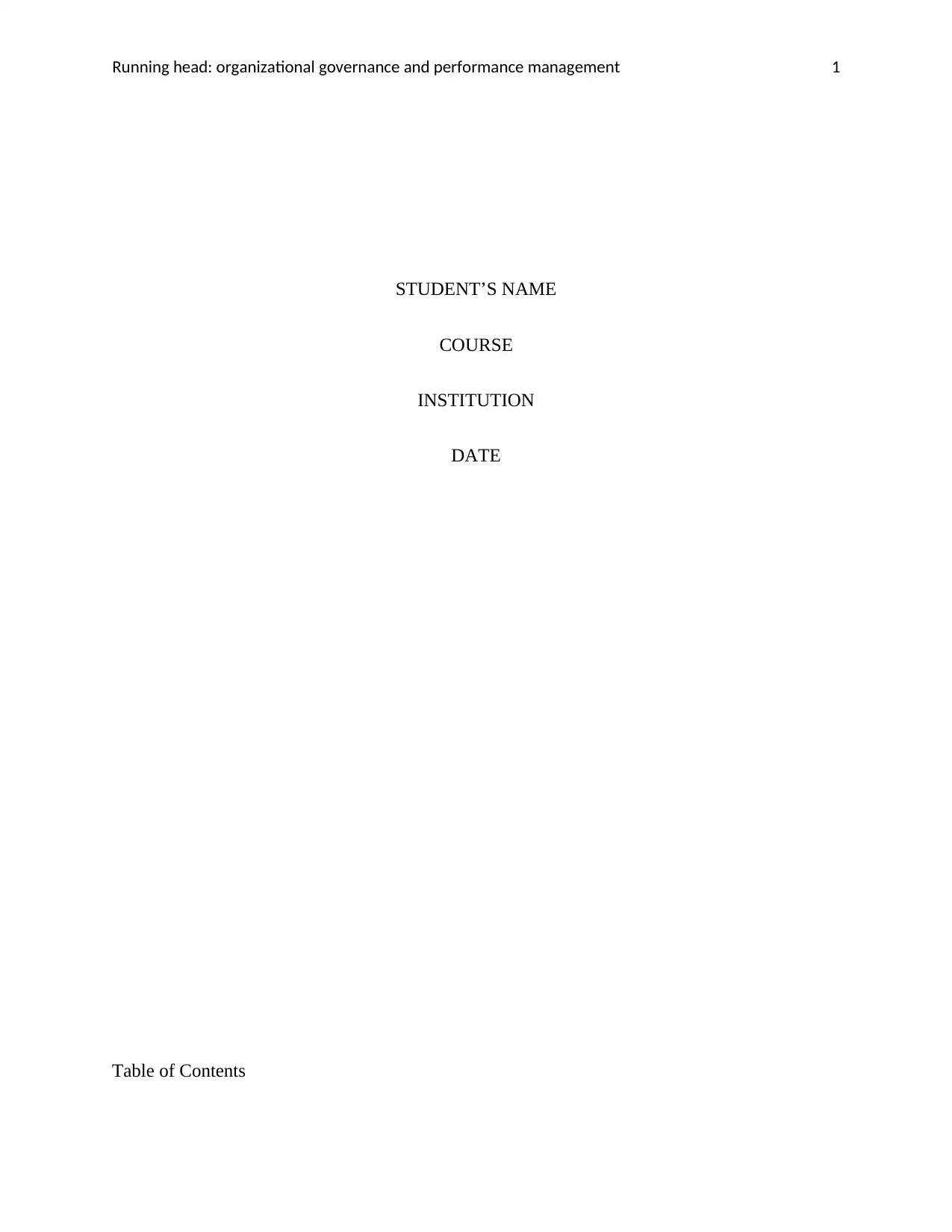
Running head: organizational governance and performance management 1
STUDENT’S NAME
COURSE
INSTITUTION
DATE
Table of Contents
STUDENT’S NAME
COURSE
INSTITUTION
DATE
Table of Contents
Paraphrase This Document
Need a fresh take? Get an instant paraphrase of this document with our AI Paraphraser
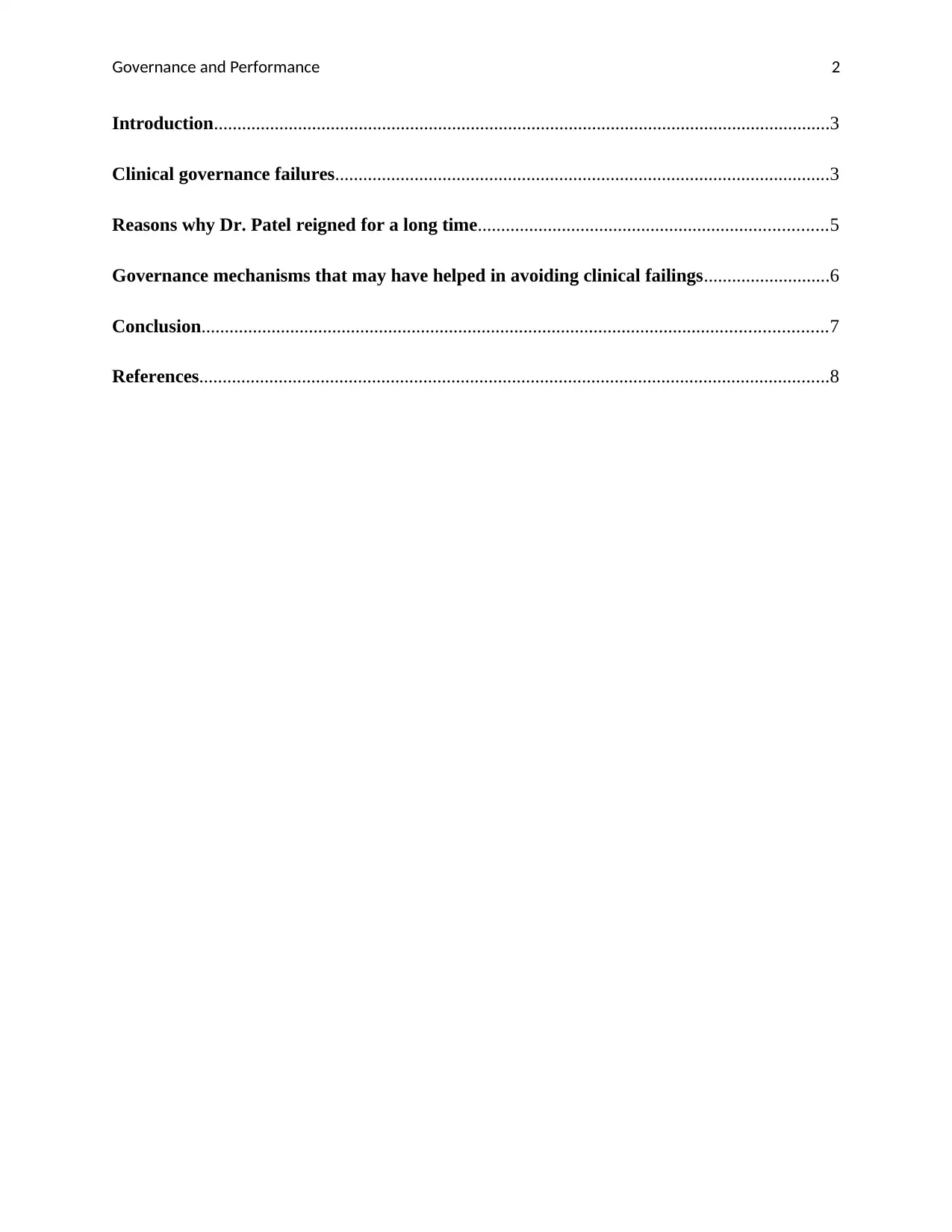
Governance and Performance 2
Introduction....................................................................................................................................3
Clinical governance failures..........................................................................................................3
Reasons why Dr. Patel reigned for a long time...........................................................................5
Governance mechanisms that may have helped in avoiding clinical failings...........................6
Conclusion......................................................................................................................................7
References.......................................................................................................................................8
Introduction....................................................................................................................................3
Clinical governance failures..........................................................................................................3
Reasons why Dr. Patel reigned for a long time...........................................................................5
Governance mechanisms that may have helped in avoiding clinical failings...........................6
Conclusion......................................................................................................................................7
References.......................................................................................................................................8
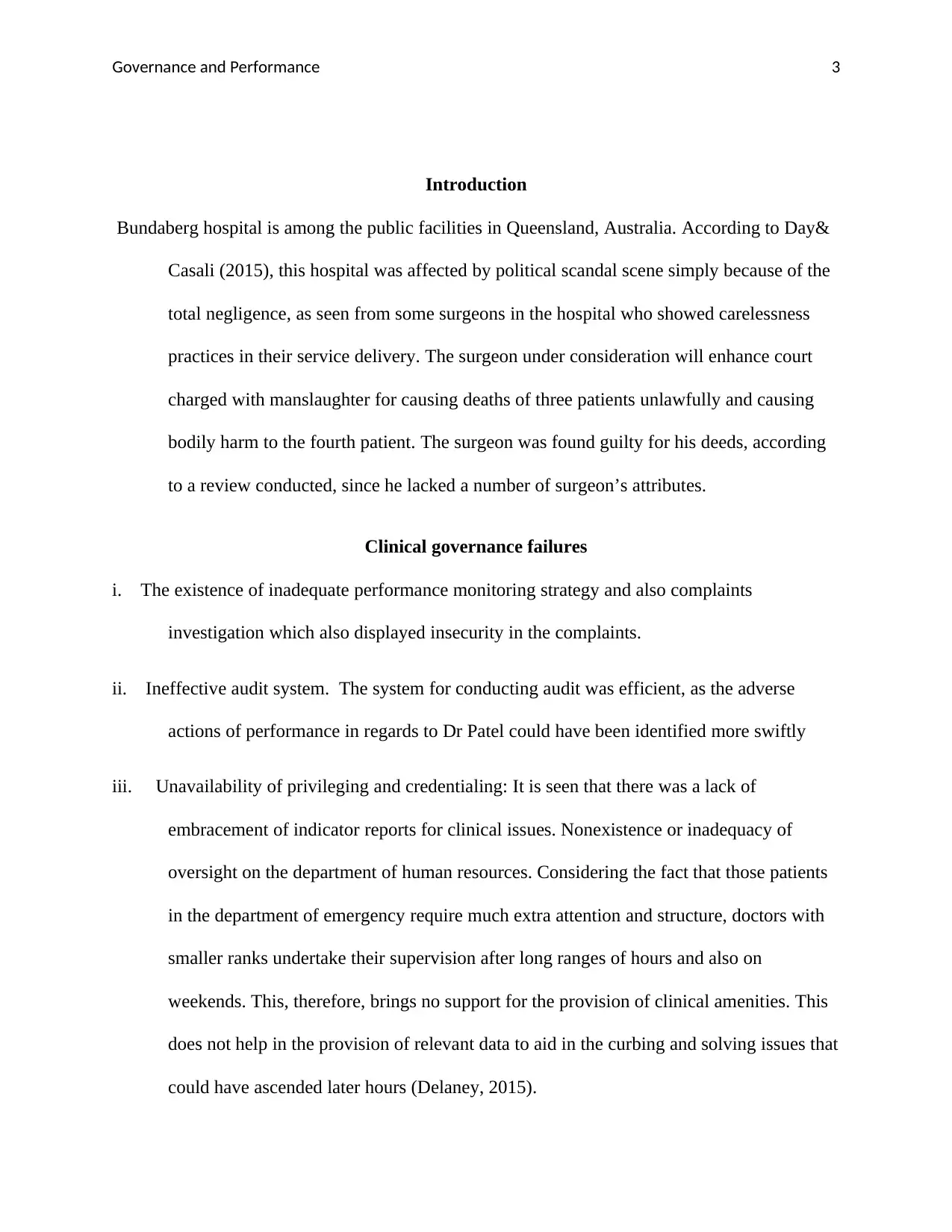
Governance and Performance 3
Introduction
Bundaberg hospital is among the public facilities in Queensland, Australia. According to Day&
Casali (2015), this hospital was affected by political scandal scene simply because of the
total negligence, as seen from some surgeons in the hospital who showed carelessness
practices in their service delivery. The surgeon under consideration will enhance court
charged with manslaughter for causing deaths of three patients unlawfully and causing
bodily harm to the fourth patient. The surgeon was found guilty for his deeds, according
to a review conducted, since he lacked a number of surgeon’s attributes.
Clinical governance failures
i. The existence of inadequate performance monitoring strategy and also complaints
investigation which also displayed insecurity in the complaints.
ii. Ineffective audit system. The system for conducting audit was efficient, as the adverse
actions of performance in regards to Dr Patel could have been identified more swiftly
iii. Unavailability of privileging and credentialing: It is seen that there was a lack of
embracement of indicator reports for clinical issues. Nonexistence or inadequacy of
oversight on the department of human resources. Considering the fact that those patients
in the department of emergency require much extra attention and structure, doctors with
smaller ranks undertake their supervision after long ranges of hours and also on
weekends. This, therefore, brings no support for the provision of clinical amenities. This
does not help in the provision of relevant data to aid in the curbing and solving issues that
could have ascended later hours (Delaney, 2015).
Introduction
Bundaberg hospital is among the public facilities in Queensland, Australia. According to Day&
Casali (2015), this hospital was affected by political scandal scene simply because of the
total negligence, as seen from some surgeons in the hospital who showed carelessness
practices in their service delivery. The surgeon under consideration will enhance court
charged with manslaughter for causing deaths of three patients unlawfully and causing
bodily harm to the fourth patient. The surgeon was found guilty for his deeds, according
to a review conducted, since he lacked a number of surgeon’s attributes.
Clinical governance failures
i. The existence of inadequate performance monitoring strategy and also complaints
investigation which also displayed insecurity in the complaints.
ii. Ineffective audit system. The system for conducting audit was efficient, as the adverse
actions of performance in regards to Dr Patel could have been identified more swiftly
iii. Unavailability of privileging and credentialing: It is seen that there was a lack of
embracement of indicator reports for clinical issues. Nonexistence or inadequacy of
oversight on the department of human resources. Considering the fact that those patients
in the department of emergency require much extra attention and structure, doctors with
smaller ranks undertake their supervision after long ranges of hours and also on
weekends. This, therefore, brings no support for the provision of clinical amenities. This
does not help in the provision of relevant data to aid in the curbing and solving issues that
could have ascended later hours (Delaney, 2015).
⊘ This is a preview!⊘
Do you want full access?
Subscribe today to unlock all pages.

Trusted by 1+ million students worldwide
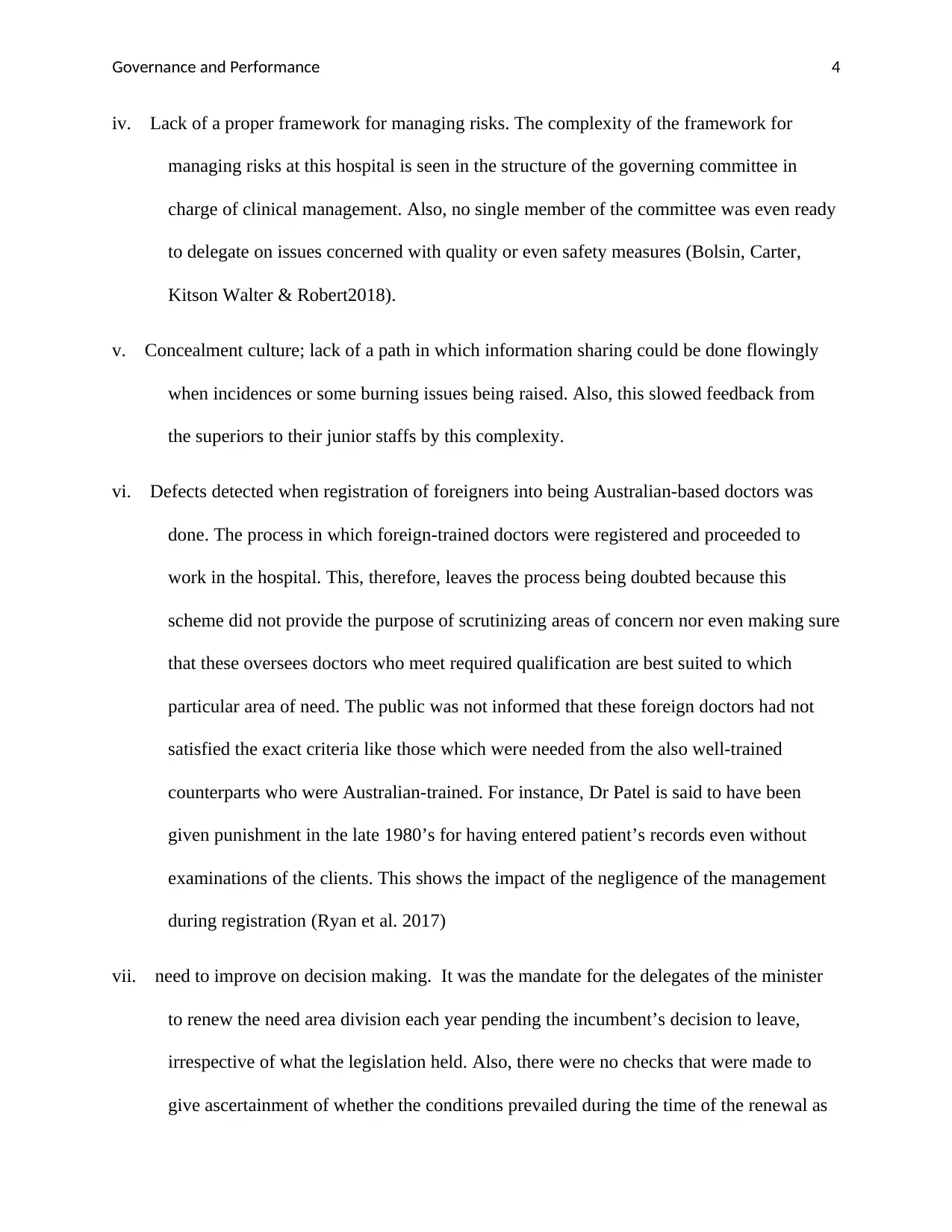
Governance and Performance 4
iv. Lack of a proper framework for managing risks. The complexity of the framework for
managing risks at this hospital is seen in the structure of the governing committee in
charge of clinical management. Also, no single member of the committee was even ready
to delegate on issues concerned with quality or even safety measures (Bolsin, Carter,
Kitson Walter & Robert2018).
v. Concealment culture; lack of a path in which information sharing could be done flowingly
when incidences or some burning issues being raised. Also, this slowed feedback from
the superiors to their junior staffs by this complexity.
vi. Defects detected when registration of foreigners into being Australian-based doctors was
done. The process in which foreign-trained doctors were registered and proceeded to
work in the hospital. This, therefore, leaves the process being doubted because this
scheme did not provide the purpose of scrutinizing areas of concern nor even making sure
that these oversees doctors who meet required qualification are best suited to which
particular area of need. The public was not informed that these foreign doctors had not
satisfied the exact criteria like those which were needed from the also well-trained
counterparts who were Australian-trained. For instance, Dr Patel is said to have been
given punishment in the late 1980’s for having entered patient’s records even without
examinations of the clients. This shows the impact of the negligence of the management
during registration (Ryan et al. 2017)
vii. need to improve on decision making. It was the mandate for the delegates of the minister
to renew the need area division each year pending the incumbent’s decision to leave,
irrespective of what the legislation held. Also, there were no checks that were made to
give ascertainment of whether the conditions prevailed during the time of the renewal as
iv. Lack of a proper framework for managing risks. The complexity of the framework for
managing risks at this hospital is seen in the structure of the governing committee in
charge of clinical management. Also, no single member of the committee was even ready
to delegate on issues concerned with quality or even safety measures (Bolsin, Carter,
Kitson Walter & Robert2018).
v. Concealment culture; lack of a path in which information sharing could be done flowingly
when incidences or some burning issues being raised. Also, this slowed feedback from
the superiors to their junior staffs by this complexity.
vi. Defects detected when registration of foreigners into being Australian-based doctors was
done. The process in which foreign-trained doctors were registered and proceeded to
work in the hospital. This, therefore, leaves the process being doubted because this
scheme did not provide the purpose of scrutinizing areas of concern nor even making sure
that these oversees doctors who meet required qualification are best suited to which
particular area of need. The public was not informed that these foreign doctors had not
satisfied the exact criteria like those which were needed from the also well-trained
counterparts who were Australian-trained. For instance, Dr Patel is said to have been
given punishment in the late 1980’s for having entered patient’s records even without
examinations of the clients. This shows the impact of the negligence of the management
during registration (Ryan et al. 2017)
vii. need to improve on decision making. It was the mandate for the delegates of the minister
to renew the need area division each year pending the incumbent’s decision to leave,
irrespective of what the legislation held. Also, there were no checks that were made to
give ascertainment of whether the conditions prevailed during the time of the renewal as
Paraphrase This Document
Need a fresh take? Get an instant paraphrase of this document with our AI Paraphraser
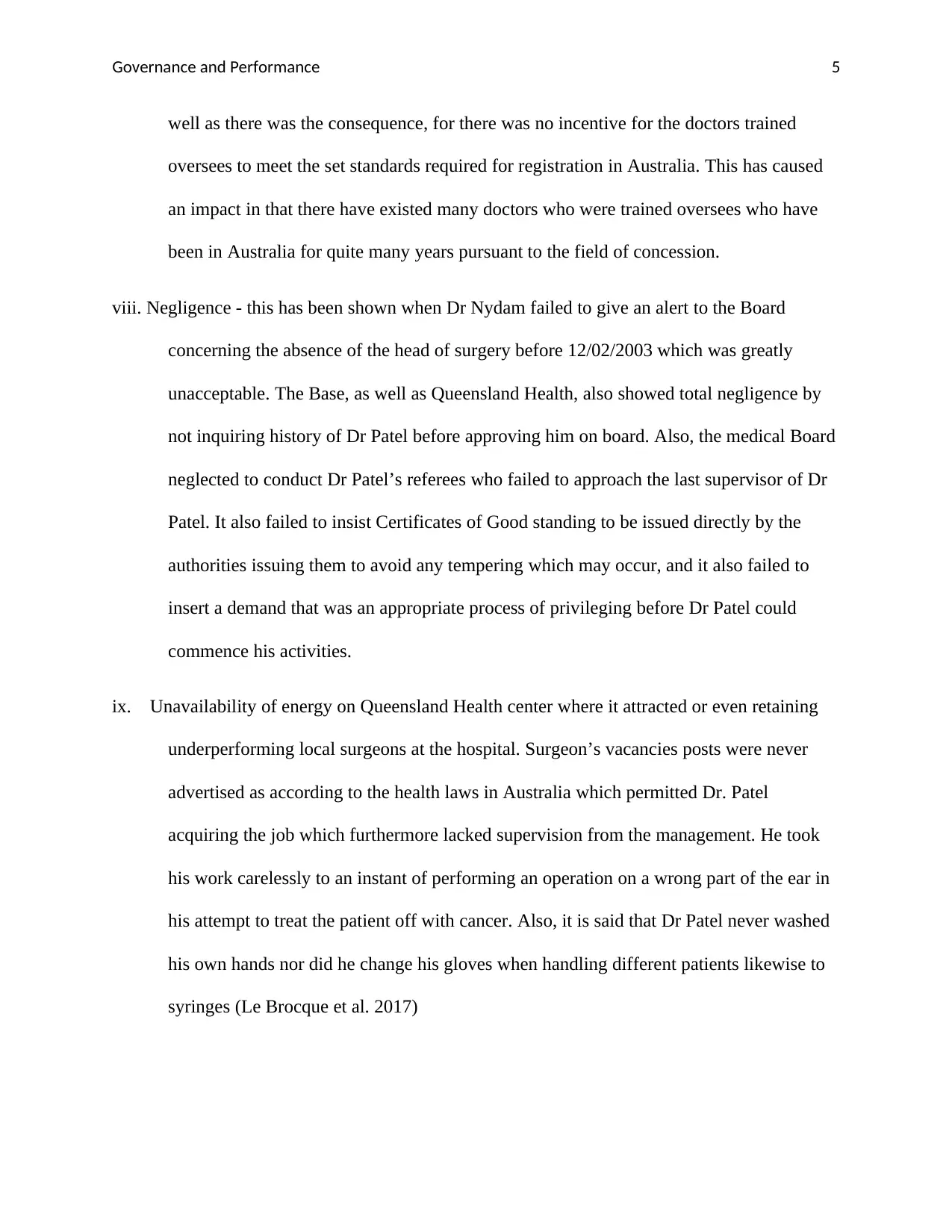
Governance and Performance 5
well as there was the consequence, for there was no incentive for the doctors trained
oversees to meet the set standards required for registration in Australia. This has caused
an impact in that there have existed many doctors who were trained oversees who have
been in Australia for quite many years pursuant to the field of concession.
viii. Negligence - this has been shown when Dr Nydam failed to give an alert to the Board
concerning the absence of the head of surgery before 12/02/2003 which was greatly
unacceptable. The Base, as well as Queensland Health, also showed total negligence by
not inquiring history of Dr Patel before approving him on board. Also, the medical Board
neglected to conduct Dr Patel’s referees who failed to approach the last supervisor of Dr
Patel. It also failed to insist Certificates of Good standing to be issued directly by the
authorities issuing them to avoid any tempering which may occur, and it also failed to
insert a demand that was an appropriate process of privileging before Dr Patel could
commence his activities.
ix. Unavailability of energy on Queensland Health center where it attracted or even retaining
underperforming local surgeons at the hospital. Surgeon’s vacancies posts were never
advertised as according to the health laws in Australia which permitted Dr. Patel
acquiring the job which furthermore lacked supervision from the management. He took
his work carelessly to an instant of performing an operation on a wrong part of the ear in
his attempt to treat the patient off with cancer. Also, it is said that Dr Patel never washed
his own hands nor did he change his gloves when handling different patients likewise to
syringes (Le Brocque et al. 2017)
well as there was the consequence, for there was no incentive for the doctors trained
oversees to meet the set standards required for registration in Australia. This has caused
an impact in that there have existed many doctors who were trained oversees who have
been in Australia for quite many years pursuant to the field of concession.
viii. Negligence - this has been shown when Dr Nydam failed to give an alert to the Board
concerning the absence of the head of surgery before 12/02/2003 which was greatly
unacceptable. The Base, as well as Queensland Health, also showed total negligence by
not inquiring history of Dr Patel before approving him on board. Also, the medical Board
neglected to conduct Dr Patel’s referees who failed to approach the last supervisor of Dr
Patel. It also failed to insist Certificates of Good standing to be issued directly by the
authorities issuing them to avoid any tempering which may occur, and it also failed to
insert a demand that was an appropriate process of privileging before Dr Patel could
commence his activities.
ix. Unavailability of energy on Queensland Health center where it attracted or even retaining
underperforming local surgeons at the hospital. Surgeon’s vacancies posts were never
advertised as according to the health laws in Australia which permitted Dr. Patel
acquiring the job which furthermore lacked supervision from the management. He took
his work carelessly to an instant of performing an operation on a wrong part of the ear in
his attempt to treat the patient off with cancer. Also, it is said that Dr Patel never washed
his own hands nor did he change his gloves when handling different patients likewise to
syringes (Le Brocque et al. 2017)
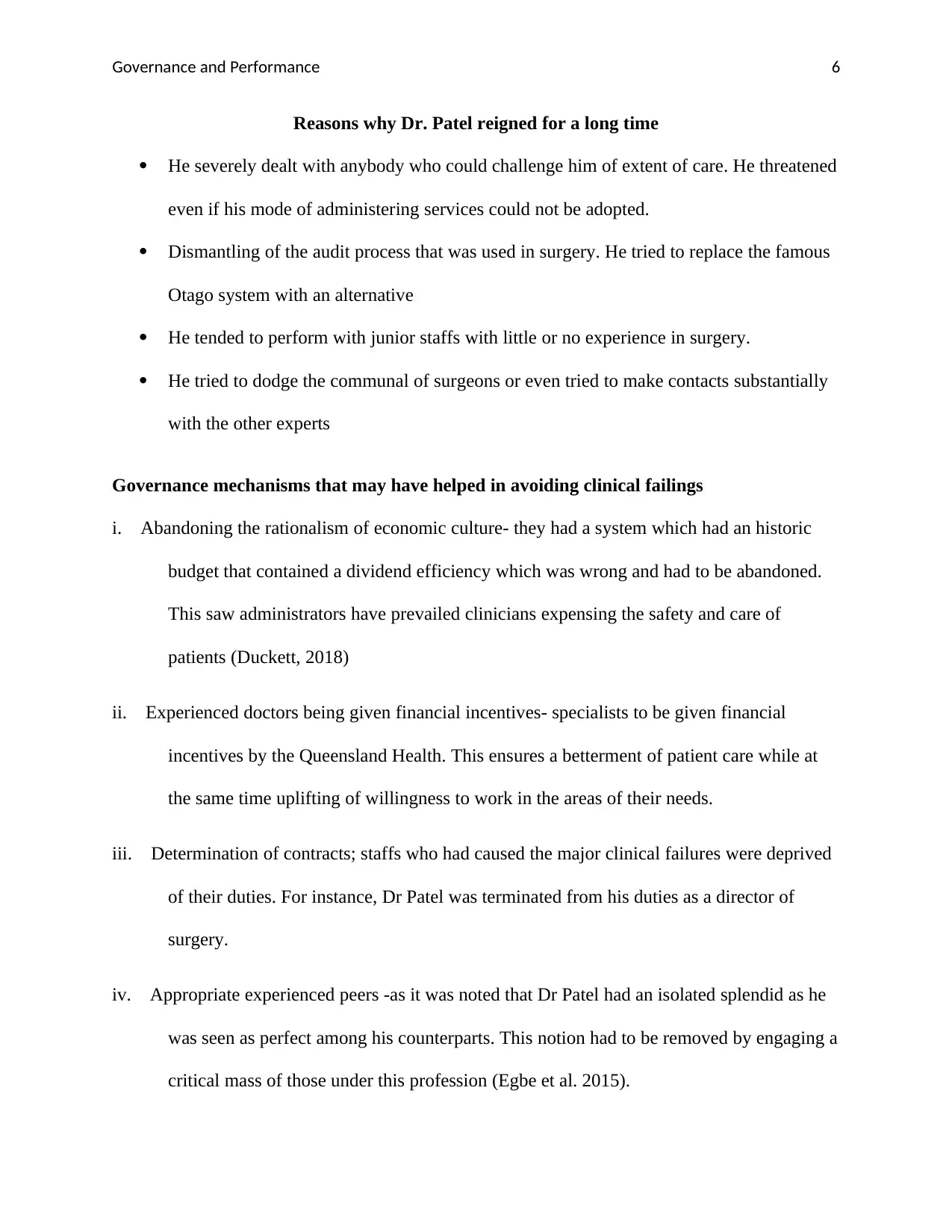
Governance and Performance 6
Reasons why Dr. Patel reigned for a long time
He severely dealt with anybody who could challenge him of extent of care. He threatened
even if his mode of administering services could not be adopted.
Dismantling of the audit process that was used in surgery. He tried to replace the famous
Otago system with an alternative
He tended to perform with junior staffs with little or no experience in surgery.
He tried to dodge the communal of surgeons or even tried to make contacts substantially
with the other experts
Governance mechanisms that may have helped in avoiding clinical failings
i. Abandoning the rationalism of economic culture- they had a system which had an historic
budget that contained a dividend efficiency which was wrong and had to be abandoned.
This saw administrators have prevailed clinicians expensing the safety and care of
patients (Duckett, 2018)
ii. Experienced doctors being given financial incentives- specialists to be given financial
incentives by the Queensland Health. This ensures a betterment of patient care while at
the same time uplifting of willingness to work in the areas of their needs.
iii. Determination of contracts; staffs who had caused the major clinical failures were deprived
of their duties. For instance, Dr Patel was terminated from his duties as a director of
surgery.
iv. Appropriate experienced peers -as it was noted that Dr Patel had an isolated splendid as he
was seen as perfect among his counterparts. This notion had to be removed by engaging a
critical mass of those under this profession (Egbe et al. 2015).
Reasons why Dr. Patel reigned for a long time
He severely dealt with anybody who could challenge him of extent of care. He threatened
even if his mode of administering services could not be adopted.
Dismantling of the audit process that was used in surgery. He tried to replace the famous
Otago system with an alternative
He tended to perform with junior staffs with little or no experience in surgery.
He tried to dodge the communal of surgeons or even tried to make contacts substantially
with the other experts
Governance mechanisms that may have helped in avoiding clinical failings
i. Abandoning the rationalism of economic culture- they had a system which had an historic
budget that contained a dividend efficiency which was wrong and had to be abandoned.
This saw administrators have prevailed clinicians expensing the safety and care of
patients (Duckett, 2018)
ii. Experienced doctors being given financial incentives- specialists to be given financial
incentives by the Queensland Health. This ensures a betterment of patient care while at
the same time uplifting of willingness to work in the areas of their needs.
iii. Determination of contracts; staffs who had caused the major clinical failures were deprived
of their duties. For instance, Dr Patel was terminated from his duties as a director of
surgery.
iv. Appropriate experienced peers -as it was noted that Dr Patel had an isolated splendid as he
was seen as perfect among his counterparts. This notion had to be removed by engaging a
critical mass of those under this profession (Egbe et al. 2015).
⊘ This is a preview!⊘
Do you want full access?
Subscribe today to unlock all pages.

Trusted by 1+ million students worldwide

Governance and Performance 7
Paraphrase This Document
Need a fresh take? Get an instant paraphrase of this document with our AI Paraphraser
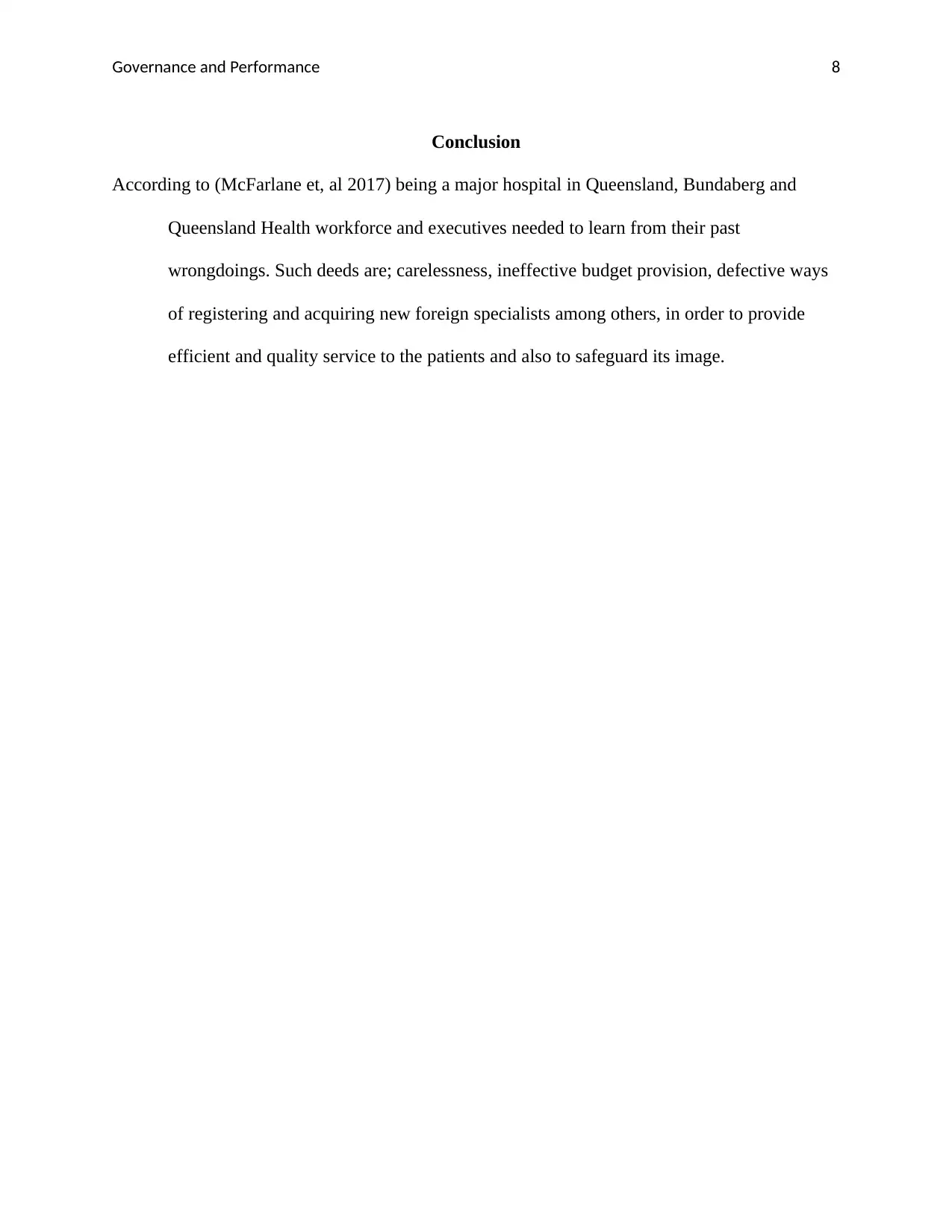
Governance and Performance 8
Conclusion
According to (McFarlane et, al 2017) being a major hospital in Queensland, Bundaberg and
Queensland Health workforce and executives needed to learn from their past
wrongdoings. Such deeds are; carelessness, ineffective budget provision, defective ways
of registering and acquiring new foreign specialists among others, in order to provide
efficient and quality service to the patients and also to safeguard its image.
Conclusion
According to (McFarlane et, al 2017) being a major hospital in Queensland, Bundaberg and
Queensland Health workforce and executives needed to learn from their past
wrongdoings. Such deeds are; carelessness, ineffective budget provision, defective ways
of registering and acquiring new foreign specialists among others, in order to provide
efficient and quality service to the patients and also to safeguard its image.
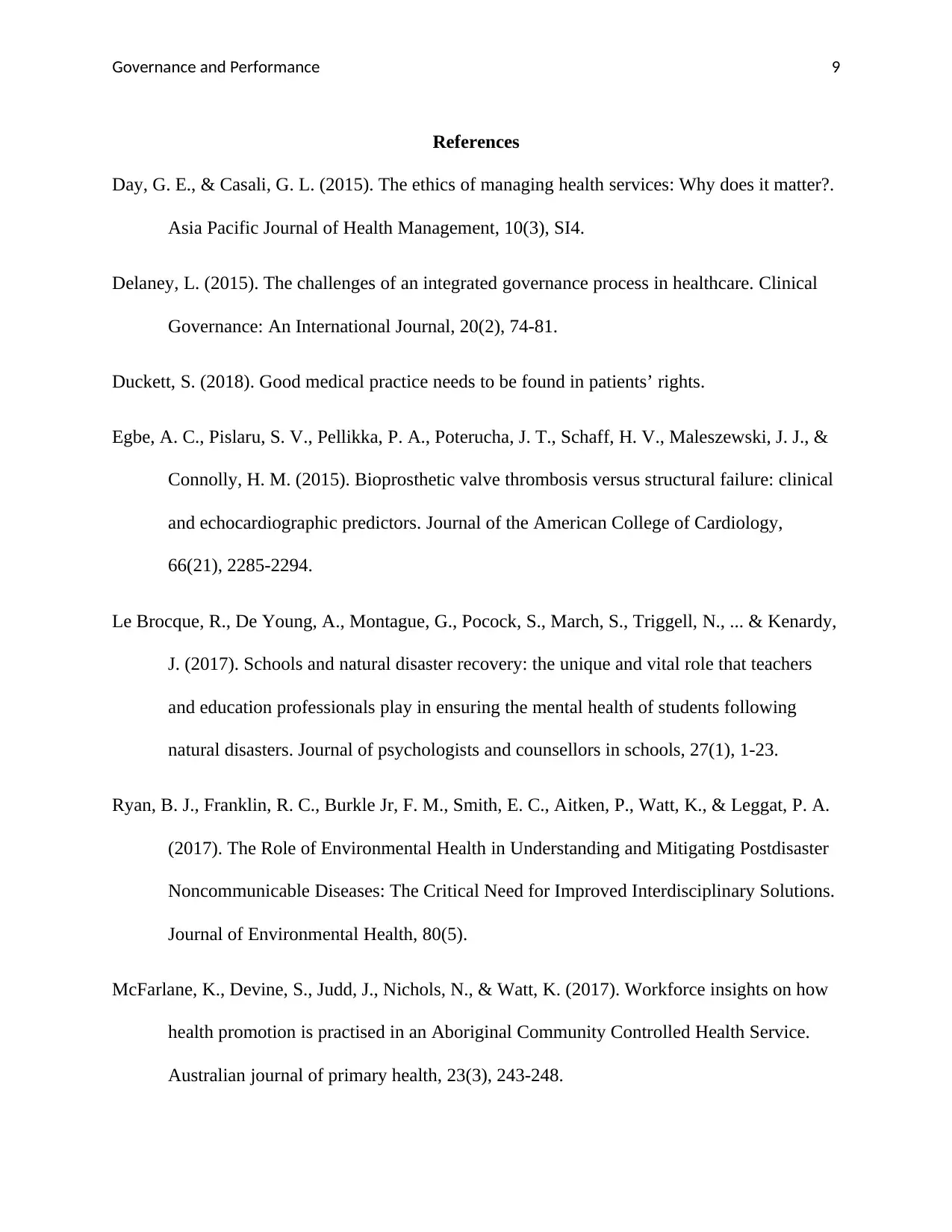
Governance and Performance 9
References
Day, G. E., & Casali, G. L. (2015). The ethics of managing health services: Why does it matter?.
Asia Pacific Journal of Health Management, 10(3), SI4.
Delaney, L. (2015). The challenges of an integrated governance process in healthcare. Clinical
Governance: An International Journal, 20(2), 74-81.
Duckett, S. (2018). Good medical practice needs to be found in patients’ rights.
Egbe, A. C., Pislaru, S. V., Pellikka, P. A., Poterucha, J. T., Schaff, H. V., Maleszewski, J. J., &
Connolly, H. M. (2015). Bioprosthetic valve thrombosis versus structural failure: clinical
and echocardiographic predictors. Journal of the American College of Cardiology,
66(21), 2285-2294.
Le Brocque, R., De Young, A., Montague, G., Pocock, S., March, S., Triggell, N., ... & Kenardy,
J. (2017). Schools and natural disaster recovery: the unique and vital role that teachers
and education professionals play in ensuring the mental health of students following
natural disasters. Journal of psychologists and counsellors in schools, 27(1), 1-23.
Ryan, B. J., Franklin, R. C., Burkle Jr, F. M., Smith, E. C., Aitken, P., Watt, K., & Leggat, P. A.
(2017). The Role of Environmental Health in Understanding and Mitigating Postdisaster
Noncommunicable Diseases: The Critical Need for Improved Interdisciplinary Solutions.
Journal of Environmental Health, 80(5).
McFarlane, K., Devine, S., Judd, J., Nichols, N., & Watt, K. (2017). Workforce insights on how
health promotion is practised in an Aboriginal Community Controlled Health Service.
Australian journal of primary health, 23(3), 243-248.
References
Day, G. E., & Casali, G. L. (2015). The ethics of managing health services: Why does it matter?.
Asia Pacific Journal of Health Management, 10(3), SI4.
Delaney, L. (2015). The challenges of an integrated governance process in healthcare. Clinical
Governance: An International Journal, 20(2), 74-81.
Duckett, S. (2018). Good medical practice needs to be found in patients’ rights.
Egbe, A. C., Pislaru, S. V., Pellikka, P. A., Poterucha, J. T., Schaff, H. V., Maleszewski, J. J., &
Connolly, H. M. (2015). Bioprosthetic valve thrombosis versus structural failure: clinical
and echocardiographic predictors. Journal of the American College of Cardiology,
66(21), 2285-2294.
Le Brocque, R., De Young, A., Montague, G., Pocock, S., March, S., Triggell, N., ... & Kenardy,
J. (2017). Schools and natural disaster recovery: the unique and vital role that teachers
and education professionals play in ensuring the mental health of students following
natural disasters. Journal of psychologists and counsellors in schools, 27(1), 1-23.
Ryan, B. J., Franklin, R. C., Burkle Jr, F. M., Smith, E. C., Aitken, P., Watt, K., & Leggat, P. A.
(2017). The Role of Environmental Health in Understanding and Mitigating Postdisaster
Noncommunicable Diseases: The Critical Need for Improved Interdisciplinary Solutions.
Journal of Environmental Health, 80(5).
McFarlane, K., Devine, S., Judd, J., Nichols, N., & Watt, K. (2017). Workforce insights on how
health promotion is practised in an Aboriginal Community Controlled Health Service.
Australian journal of primary health, 23(3), 243-248.
⊘ This is a preview!⊘
Do you want full access?
Subscribe today to unlock all pages.

Trusted by 1+ million students worldwide
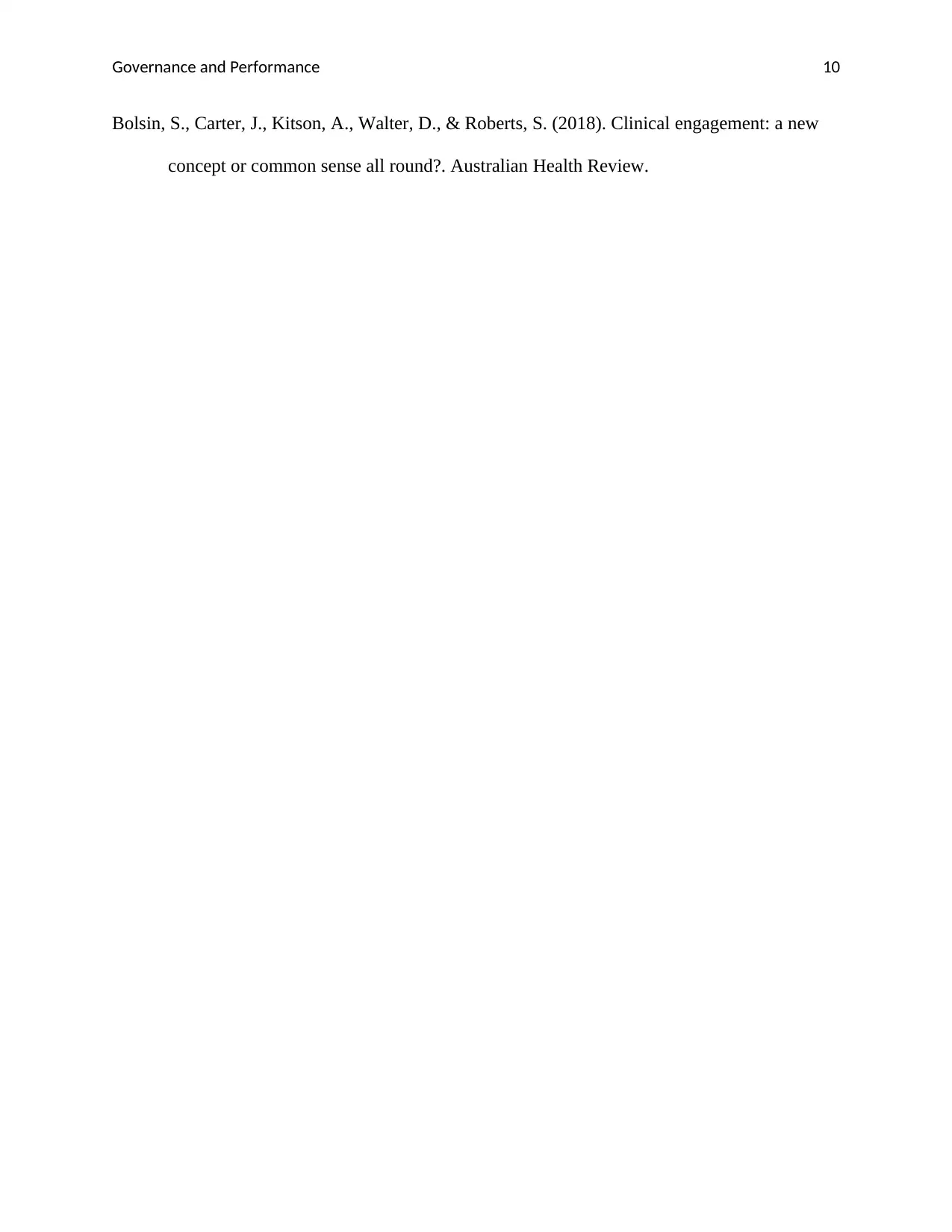
Governance and Performance 10
Bolsin, S., Carter, J., Kitson, A., Walter, D., & Roberts, S. (2018). Clinical engagement: a new
concept or common sense all round?. Australian Health Review.
Bolsin, S., Carter, J., Kitson, A., Walter, D., & Roberts, S. (2018). Clinical engagement: a new
concept or common sense all round?. Australian Health Review.
1 out of 10
Related Documents
Your All-in-One AI-Powered Toolkit for Academic Success.
+13062052269
info@desklib.com
Available 24*7 on WhatsApp / Email
![[object Object]](/_next/static/media/star-bottom.7253800d.svg)
Unlock your academic potential
Copyright © 2020–2025 A2Z Services. All Rights Reserved. Developed and managed by ZUCOL.




